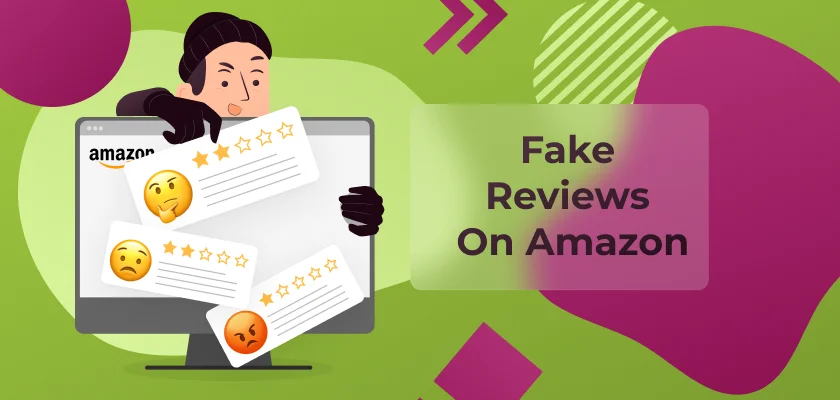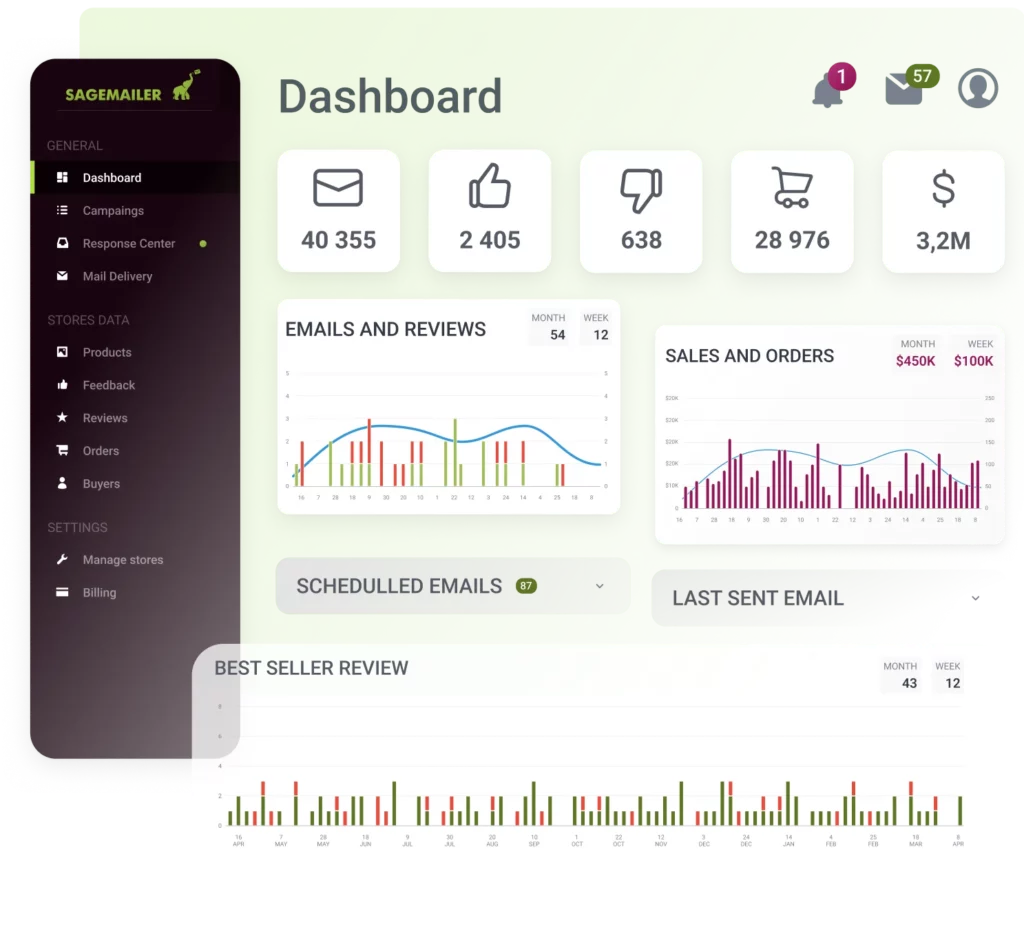Table of Contents
Modern buyers take product reviews seriously. Amazon sellers know this better than anyone else. According to the research, 95% of customers read online feedback before buying a product. And they take the reviews into account as well.
For this reason, more and more sellers are looking for an alternative solution to protect their Amazon review rating from negative reviews and fake feedback. Find out about how to remove a negative review on Amazon. Fortunately, there are some methods and specialized tools that allow you to always be aware of what is happening with your Amazon ratings and reviews.
So, how to know if an Amazon review is fake?
Red Flags to Look for in Reviews
Get started by figuring out why you are getting fake reviews as a seller. Are Amazon testimonials fake in your case? If your customers are dissatisfied with your product or service and indicate the objective reason, then you should think about the user experience you deliver.
But if the number of satisfied clients is more than 80% and there is a sudden influx of negative testimonials, then you should think about the safety of your business. Firstly, find out how to spot fake Amazon reviews. What does a fake Amazon review look like? Be guided by the following criteria.

- There is a sudden influx in the volume of the testimonials. There may be a mismatch in the number of sales and number of reviews during a certain period.
- All reviews have the same vocabulary and no specifics about product and customer service.
- The profiles of the users reviewing your products look fake and suspicious.
How to report a fake review on Amazon?
First of all, you should contact the platform support service and state that there is a suspicious Amazon review. Second, you need to remove fake Amazon feedback ASAP. For example, you can deal with it with specialized software.
Analyzing Reviewer Profiles
Spotting fake reviews on Amazon can be challenging, but by carefully analyzing reviewer profiles, you can increase your chances of identifying genuine feedback. Here’s a guide on how to assess reviewer history and activity on Amazon.
How to assess reviewer history and activity on Amazon?
- Check Reviewer’s Profile Details:
Profile Picture: Authentic reviewers often have personal photos. Be cautious of profiles with generic images or stock photos.
Profile Information: Legitimate reviewers may provide more details about themselves in their profiles. Sparse or generic information might indicate a fake account.
- Evaluate Reviewer Activity:
Frequency of Reviews: A sudden spike in the frequency of reviews, especially for a particular product or brand, may suggest incentivized or fake testimonials.
Review Length and Detail: Genuine reviewers often provide detailed feedback about their experiences. Extremely short or overly positive reviews without substance might be suspicious.
- Analyze Reviewer History:
Diverse Product Reviews: Authentic reviewers typically review a variety of products across different categories. A sudden shift in focus to one particular brand or type of product can be a sign of bias.
Consistency in Tone and Language: Look for consistent writing styles and language use across feedback. If you notice drastic changes, it could indicate different authors or fake reviews.
- Check for Patterns:
Pattern of Positive or Negative Reviews: Be wary if a reviewer consistently gives extremely positive or negative feedback. Genuine customers usually have a mix of opinions based on their experiences.
Similar Phrasing Across Reviews: Identical phrases or sentences in multiple testimonials may suggest a coordinated effort, possibly from a group of fake reviewers.
- Verify Purchase Dates:
Review Timing: Fake feedback may be posted in a short time frame or around the same date. Legitimate reviews are usually spread over time as customers use the product.
Checking for Verified Purchases

Another aspect of how to figure out a fake Amazon review is to consider whether the reviewer has made a verified purchase. A verified purchase means that the person leaving the review has actually bought the product through Amazon. It adds a layer of authenticity, reduces the likelihood of encountering fake reviews, and helps shoppers make more informed decisions based on the experiences of actual customers.
Why is it important to check for verified purchases?
1. It enhances credibility
Reviews from verified purchases are generally considered more reliable and trustworthy. The reviewer has firsthand experience with the product, lending credibility to their feedback.
2. It reduces fake reviews
Many fake reviewers or those incentivized to leave positive feedback may not go through the process of purchasing the product. Checking for verified purchases helps filter out testimonials from individuals who haven’t used the item.
3. It confirms product interaction
A verified purchase confirms that the reviewer has interacted with the product they are reviewing. This is essential for making informed decisions as the review is based on personal usage rather than hearsay.
4. It is Amazon’s trustworthiness indicator
How does Amazon put efforts to spot fake reviews? Amazon’s own system identifies and highlights verified purchase reviews, signaling to shoppers that these reviews are more likely to be genuine. This feature reinforces the importance of considering verified purchases in the decision-making process.
Comparing Reviews with Similar Products
Comparing reviews with similar products can be an effective strategy for spotting fake testimonials on Amazon by revealing patterns, inconsistencies, and anomalies. Here’s how:
- Inconsistencies in Language and Tone: Fake reviews are often generated by the same source, leading to similarities in language and tone. Look for inconsistencies in writing style, phrasing, or overly positive/negative language that might indicate a coordinated effort to manipulate reviews.
- Sudden Influx of Positive or Negative Reviews: If a particular product has a sudden influx of positive or negative testimonials compared to similar items in the same category, it could be a sign of manipulation. A significant deviation from the norm may indicate an attempt to artificially boost or undermine a product’s reputation.
- Similar Reviewer Names Across Products: Fake reviewers may use similar or identical names across different products. When comparing feedback with similar products, check if the same set of reviewer names appears frequently. This could suggest a coordinated effort to create fake accounts and post reviews.
- Overemphasis on Specific Features: Fake reviews may focus excessively on specific features or aspects of a product to create a false narrative. By comparing testimonials with similar products, you can identify whether the highlighted features are consistent with what genuine customers find important or if they seem exaggerated and out of place.
- Identical or Similar Content: Fake reviews may reuse content across multiple products. When comparing feedback, look for identical or strikingly similar reviews posted for different items. Genuine testimonials are likely to be more unique and specific to the product in question.
- Patterns of Review Posting: Fake feedback may follow patterns in terms of posting frequency and timing. For example, a sudden surge in positive reviews around the same date could indicate a coordinated effort. By comparing the review history of similar products, you can identify unusual patterns that might suggest manipulation.
Utilizing Review Analysis Tools to Spot Fake Reviews on Amazon
In addition to manually comparing feedback with similar products, you can leverage specialized review analysis tools to enhance your ability to spot fake testimonials on Amazon. These tools use algorithms and data analytics to identify patterns, anomalies, and other indicators of potentially inauthentic feedback. Here’s how these tools can be beneficial:
- Automated Pattern Recognition: Review analysis tools use algorithms to automatically detect patterns indicative of fake feedback. These patterns may include similarities in language, posting frequency, or the use of specific phrases commonly associated with fake feedback.
- Sentiment Analysis: Many review analysis tools incorporate sentiment analysis to assess the emotional tone of feedback. Fake feedback may exhibit overly positive or negative sentiments without providing meaningful details. These tools can help identify testimonials that deviate from the expected sentiment distribution.
- Reviewer Behavior Analysis: Tools often analyze the behavior of reviewers, looking for unusual patterns such as a sudden increase in review activity, posting similar feedback across multiple products, or consistently providing extreme ratings. These behaviors can be indicative of review manipulation.
- Verification of Verified Purchases: Some tools cross-check the verification status of purchases associated with feedback. This helps in identifying fake feedback posted by individuals who haven’t actually bought the product.
- Historical Reviewer Data: Review analysis tools may maintain databases of historical reviewer data, helping to identify patterns across multiple reviews and products. This comprehensive view can reveal if a reviewer has a history of posting suspicious or fake reviews.
- Graphical Representation of Data: Visualization features in these tools provide graphical representations of review data, making it easier to identify outliers, clusters of similar testimonials, and other anomalies.
- Notification and Reporting Features: Some tools offer notification features to alert users about suspicious feedback. Additionally, they may provide reporting functionalities to help users report potentially fake testimonials directly to Amazon for further investigation.
Fake Review Analysis Feature in SageMailer
Relying on the fake review Amazon team to deal with your testimonials is not a good idea. Your online reputation is your responsibility, so take care of it. Check the feedback from your customers and quickly respond to negative testimonials. In this case, the SageMailer tool can help.
Why choose this service? Here are the main features worth your attention.
- Get instantly notified of new reviews. What’s more, you can configure this function so that you receive a notification only for negative testimonials that require an immediate response. Such notifications can be sent to multiple email addresses if you have a large support service team.
- Track unusual patterns. The tool not only notifies you of new testimonials but also allows you to analyze trends and spot any unusual activity. If you see a sudden spike in reviews, It could indicate an effort to boost or damage the product’s reputation artificially. Moreover, with SageMailer, you can monitor and manage all your Amazon feedback effortlessly.
- Launch a feedback campaign with automated messaging. It will help to motivate your users to leave feedback about the product. This is a good way for those whose buyers aren’t too eager to leave their feedback or use a one-tap star rating function only. Such tools can help you enhance the percentage of buyers who share feedback. In turn, it will increase sales as your clients will have more confidence in your brand and more details to make an informed decision. Check our FeedbackExpress review to learn about this app and its alternatives. Third-party software is a nice fit when it comes to feedback and product review request automation. Check the features and pricing reviews to find the best option.
- Chat with buyers. This tool offers a simple and user-friendly interface through which you can communicate with your customers right within the tool.
It’s worth noting that this software is free to get started with. Test the ways it spots fake feedback and unlocks the opportunity to manage your online reputation better!

Check this article to find out more about different review monitoring software and SageMailer’s benefits compared to Feedbackz.
Conclusion: How to Identity Fake Amazon Review
That’s all. Now you know how to tell if an Amazon review is fake.
Being guided by reviews is one of the features of modern online shopping. That’s why such practices as creating fake testimonials are common on Amazon. Still, you have the opportunity to deal with them and secure your business from unfounded negativity and the antics of competitors. Consider using SageMailer for this purpose and stay updated on your customer feedback and reputation on Amazon!



It’s easy to c which reviews are fake!
Thanks for your explanation on this topic. What really bothers me are users are misusing the product and then giving it a poor review.
I was on Amazon few days ago and saw a bunch of those fake reviews. Hope Amazon team will get rid of those asap!
Hey! I am not a new seller. I have my reputation on the market and SageMailer really helps. I don’t miss any negative feedback so I can deal with it immediately to gain back my customers’ trust. Also chatting with buyers is really a time-consuming thing.
Top content, really just to the point. Saved me a lot of time. Thanks!
Very helpful information